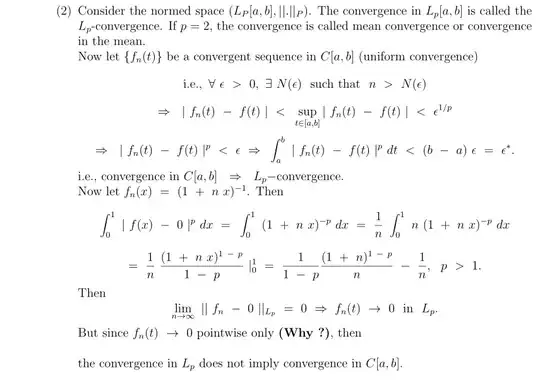First, note that the supremum norm of $C[a,b]$ is the norm of uniform convergence. This means a sequence $f_n \to f$ wrt. to $||\, .\, ||_\infty$ if and only if $f_n \to f$ uniformly. Make sure that you understand why this is true and that you know the difference between pointwise and uniform convergence.
$f_n \to f$ with respect to $||\, .\, ||_p$ means only that
\begin{align}
\int_a^b |f_n(t) - f(t)|\, d\lambda(t) \to 0 \qquad \text{as} \qquad n \to \infty
\end{align}
It doesn't say anything about pointwise or uniform convergence from first sight. In fact there are examples, where $f_n \to f$ with respect to the $L^p$-norm, but $f_n(x) \to f(x)$ at no point $x \in (a,b)$. See eg. the answer to this question: Does convergence in $L^{p}$ implies convergence almost everywhere?.
Your counterexample is a little bit difference. You have a sequence of functions that converges in $L^p$ and that converges pointwise (i.e. $\forall x \in [a,b]:f_n(x) \to f(x)$ for some function $f$). But the sequence does not converge uniformly. To see this, just compute the maximum distance between two elements $\sup_{t\in [a,b]} |f_n(t) - f_m(t)| = ||f_n - f_m||_\infty$. So it is an example that convertgence in $L^p[a,b]$ does not imply convergence in $C[a,b]$.
There are other ways to see, that this can not be true. Suppose I have $f_n \to f$ in $L^p$. If I change $f$ in point, then it won't do anything to the intgrals, so still $f_n \to f'$. But it can definitly change pointwise (and hence also uniform) convergence.
I hope this helps a little bit. "Why is the continuous function $f_n(x)=(1+nx)^{−1}$ pointwise convergent to zero in $(L^p(a,b),∥.∥_p)$?" does not make a lot of sense as a question, since the $L^p$ does not care about any properties on sets of measure zero (which includes single points).
